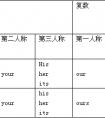改错。1. 这是一本英语书。 This is a English book.2. 这是什么?是书包。 What's this? It's bag. 3. 那个用英语怎么说? What's that English? 4. 这是苹果,那-七年级英语
如果有两个或两个以上的形容词修饰一个名词时,则由它们和被修饰的名词之间的密切程度而定,越密切的形容词越靠近名词。
如果几个形容词的密切程度差不多则按音节少的形容词放在前面,音节多的形容词放在后面。
2.当形容词所修饰的词是由some,any,every,no等构成的不定代词时,形容词必须置于名词之后。例如:?
She has something new to tell me.?她有一些新的情况告诉我。?
I have nothing important to do today.?今天我没有重要的工作要做。?
Do you know anybody else here??这儿你还有认识的人吗??
3.形容词后面有介词短语或不定式短语时,形容词必须置于名词之后。例如:?
It is a problem difficult to work out.?这是一道难以解决的问题。?
Edison is a student difficult to teach.?爱迪生是个很难教的学生。?
This is a kind of flowers easy to grow.?这是一种易栽的花。?
4.用 and 或 or 连接起来的两个形容词作定语时一般把它们放在被修饰的名词后面。起进一步解释的作用。例如:?
All people,young or old,should be strict with themselves.?
所有的人,无论老少,都应该严格要求自己。?
We are building a new school, modern and super.?
我们正在建一所现代化的高档次的新型学校。?
All countries, rich and poor, should help one another. 所有的国家,无论穷富都应该互相帮助。?
5.有少数形容词,如enough和possible,既可置于所修饰的名词前面也可以置于它所修饰的名词之后。例如:?
Do you have enough time(time enough)to prepare?你有足够的时间做准备吗??
Maybe it will be a possible chance(chance possible)for you.或许它将成为一次可能的机遇。
6.有些形容词,置于名词之前与之后,含义不尽相同。例如:?
the writer present 出席的作者?
the present writer 现在的作者?
7.表示长,宽,高,深,及年龄的形容词,应放在相应的名词之后。
This river is about 100 metres wide.
The building is more than 50 metres tall.
He is less than 40 years old.
8. enough修饰名词时,在名词前后都可以。
They said that they had enough food.= They said that they had food enough.
enough 修饰形容词和副词,位于其后。
He is old enough to join the army.
He isn’t old enough to go to school.
9.形容词else通常放在疑问代词,疑问副词或不定代词后
what/who/where/when/when else
something/anything/nothing…else
What else did you do?
Do you have anything else to say?
10.由两个或两个以上的词组成的形容词词组修饰名词时须放在名词之后。
This is the book easy to read.
这是一本容易读的书。
名词化的形容词:
有些形容词可以和定冠词连用,表示一类人或事物,这时,它相当于一个名词,可作主语或宾语;
表示一类人时,看作复数,表示一类事物时,通常看作单数。
Robin Hooh(罗宾汉) hated the rich and loved the poor.
The old are taken good care of in American.
the+形容词,常见的短语有:
the old/the young/the sick/the white/
the black/the rich/the poor/the dead(死者)
形似副词的形容词:
以-ly结尾的词通常是副词,但是下列词为形容词。
friendly lonely (孤独的) ;lively (活着的);lovely(可爱的)
复合形容词的类型:
(1)名词+过去分词 man-made satellite 人造卫星
(2)形容词+现在分词 a good-looking man
(3)形容词+名词 second-hand cars
(4)数词+名词-ed three-legged chairs三条腿的椅子
(5)数词+名词 400- metre race
(6)副词+现在分词 hard-working students
(7)副词+过去分词 well-known writers
(8)形容词+形容词 a dark-red jacket
(9)形容词+过去分词 ready-made clothes 成品服装
含有形容词的常用句型:
(1) It’s+adj. of sb. to do sth.
(good/ kind/nice/polite/clever/foolish… )
It’s very kind of you to help me.
(2) It’s +adj. for sb. to do sth.
(difficult/easy/hard/dangerous/usefulinteresting/important…)
It’s important for us to learn English well.
(3)下列形容词后常跟动词不定式
表示情感或情绪的形容词:glad,pleased,sorry,sad,afraid,thankful…
I'm glad to see you.
表示能力,意志或推测的形容词:ready,able,sure,certain…
I’m sorry to hear that.
某些现在分词和过去分词可作形容词
the moving story 令人感动的故事
a moved boy 一个被感动的男孩
a frightened child 一个被吓到的孩子
a frightening film 一个恐怖电影
考点名称:系动词
- 系动词:
亦称连系动词。作为系动词,它本身有词义,但不能单独用作谓语,后边必须跟表语,亦称补语(形容词),构成系表结构说明主语的状况、性质、特征等情况。 - 系动词的分类:
1)状态系动词
用来表示主语状态,只有be一词,例如:
He is a teacher. 他是一名教师。(is与补足语一起说明主语的身份。)
2)持续系动词
用来表示主语继续或保持一种状况或态度,主要有keep, rest, remain, stay, lie, stand, 例如:
He always kept silent at meeting. 他开会时总保持沉默。
This matter rests a mystery. 此事仍是一个谜。
3)表像系动词
用来表示"看起来像"这一概念,主要有seem, appear, look, 例如:
He looks tired. 他看起来很累。
He seems (to be) very sad. 他看起来很伤心。
4)感官系动词
感官系动词主要有feel, smell, sound, taste, 例如:
This kind of cloth feels very soft.
这种布手感很软。
This flower smells very sweet.
这朵花闻起来很香。
5)变化系动词
这些系动词表示主语变成什么样,变化系动词主要有become, grow, turn, fall, get, go, come, run.
例如:
He became mad after that. 自那之后,他疯了。
She grew rich within a short time. 她没多长时间就富了。
6)终止系动词
表示主语已终止动作,主要有prove, turn out, 表达"证实","变成"之意,例如:
The rumor proved false. 这谣言证实有假。
The search proved difficult. 搜查证实很难。
His plan turned out a success. 他的计划终于成功了。(turn out表终止性结果) 系动词使用的注意事项:
系动词本身有一定的词义,不能单独作谓语,后面必须与表语连用。复习系动词时,必须注意以下几个问题:<?xml:namespace prefix = "o" ns = "urn:schemas-microsoft-com:office:office" />1.be是最重要的系动词,主语不同,be的形式也不同,且有时态的变化。
a通常表示主语的特征、状态和身份等,后面接形容词、副词、名词、介词短语、不定式、v-ing、过去分词及表语从句作表语。
b特别要注意“由be+过去分词”所构成的系表结构与“由be+过去分词”所构成的被动语态的区别。
c前者侧重于表示主语的特征或所处的状态,通常没有由by引导的介词短语。
如:The door was closed.
后者侧重于强调主语是谓语动词所示动作的承受者,表示动作;句中可以用由by引导的介词短语。如:The door was closed by me.
- 最新内容
- 相关内容
- 网友推荐
- 图文推荐
上一篇:It is ______. [ ]A. brown deskB. brown desks C. a brown desk D. brown a desk-七年级英语
下一篇:单项选择。— By the way, have you got E-mail address? — Oh, yes, it's rggren@hotmail.com. [ ]A. theB. an C. a D. / -七年级英语
零零教育社区:论坛热帖子
| [家长教育] 孩子为什么会和父母感情疏离? (2019-07-14) |
| [教师分享] 给远方姐姐的一封信 (2018-11-07) |
| [教师分享] 伸缩门 (2018-11-07) |
| [教师分享] 回家乡 (2018-11-07) |
| [教师分享] 是风味也是人间 (2018-11-07) |
| [教师分享] 一句格言的启示 (2018-11-07) |
| [教师分享] 无规矩不成方圆 (2018-11-07) |
| [教师分享] 第十届全国教育名家论坛有感(二) (2018-11-07) |
| [教师分享] 贪玩的小狗 (2018-11-07) |
| [教师分享] 未命名文章 (2018-11-07) |

![— Do you know Meimei? — Yes, she is from a university and she is _____ honest girl. [ ]A. a B. an C. / -九年级英语](http://www.00-edu.com/d/file/ks/4/2/budingguanciaan/2019-11-29/small4247048cc84563d0252c1b027b2033211574983264.png)
![—Did that sportsman win ____ gold medal at ____Athens Olympics?—Yes, he did.[ ]A. a; an B. a; theC. a; / D. /; the-九年级英语](http://www.00-edu.com/d/file/ks/4/2/budingguanciaan/2019-11-29/small06f379c6a3c3ac9bb311d3a899491d161574984708.png)
![We don’t think she is ____ honest girl. [ ]A. a B. an C. the D. /-八年级英语](http://www.00-edu.com/d/file/ks/4/2/budingguanciaan/2019-11-29/small71b0b51d70c69d2813b4c24ce33ea1331574983883.png)
![— Do you have _____ MP3? — NO, I don't.[ ]A. a B. an C. the -九年级英语](http://www.00-edu.com/d/file/ks/4/2/budingguanciaan/2019-11-29/smallb4936ea5ddac8c680b9d3e87837821eb1574983324.jpg)

